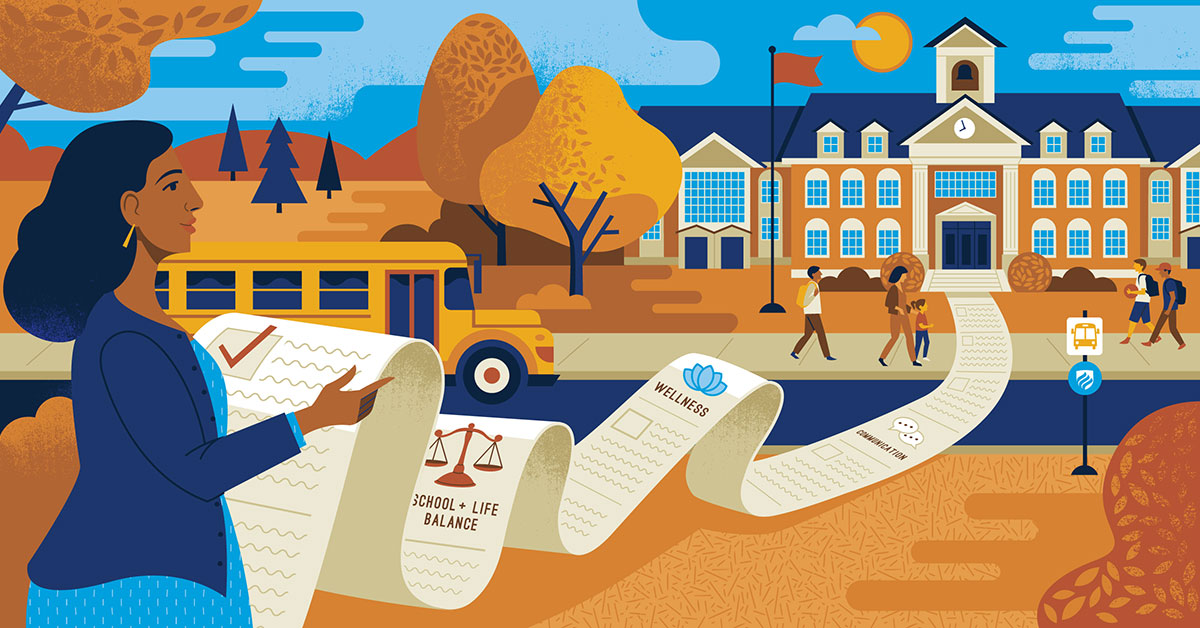5 Things to Put on your Teacher Mental Health Checklist
CHALKING THE LINE | BY THERESA ROBINSON | 5 MIN READ

Not too far in the distant past, teachers were engaging in back-to-school rituals. We are now trying to make it to the end of the school year across all levels — elementary, high school and university.
Just like back-to-school activities, end-of-school activities are seasonal and nostalgic for families, students and educators. These rites are perennial, like tulips peeking out from the soil in our yards and gardens.
And yet, amid all the rituals, amid all the thinking about what we’re doing, we teachers often forget to stop and think about how we’re doing. We must center our wellness and strive for the elusive work-life balance.
This is especially important in light of the burnout many teachers have continued to experience since the dual pandemics of the COVID-19 virus and racial/social injustice took a toll on their mental health.
Teaching is a caring profession, and every interaction with a student, colleague or family requires energy. By the end of the day or work week, we may feel drained and exhausted. Near the end of the school year many experience burnout.
So, as most of us approach the end of our school year, here is a checklist for teachers to remember as they continue to engage in the important task of educating the next generation.
Activate the Senses for Teacher Mental Health and Well-Being
Do not wait to get overwhelmed with grading, parent-teacher conferences and administrative demands. Activate your senses now to head off the impact of work-related stress. Here are some tips to keep self-care at the center of your professional practice while teaching and caring for others.
Use the “Big Five” — touch, hearing, sight, smell and taste. Choose one or more of these senses daily as areas to remember your well-being and mental health.
- Touch: Give a big hug to someone you love or care deeply for. A recent study cited in the magazine Psychology Today (November/December 2022) reported on the benefits of hugs. The study found that hugging provided a mood boost for some groups of people, affected the well-being of certain demographic groups — and that people who hugged had a more positive mood.
- Hearing: Develop a trusting support group inside and outside the school setting. Talk about your feelings, doubts, concerns and stressors with others in the field who understand the demands of the profession. Colleagues inside the school setting may have shared experiences and advice that can ease the burden of stress. Family and friend groups outside of the school setting may also provide support. Talking and receiving support can make you feel better. Finally, listen to music or sounds that bring your joy.
- Sight: Visit a museum, art gallery, play, dance recital or movie to view something aesthetically pleasing. The visual and performing arts open our hearts and minds to creative expression in a way that activates all our senses through sight. Embellish your workspace with pictures, drawings and paintings that bring about a feeling of joy. Get outside and view the natural world around you. Visit a park, forest preserve, lake or natural setting. Spending time in nature has proven to support mental well-being for some.
- Smell: The sense of smell activates regions of the human brain. Use aromatherapy in your workspace to create an environment pleasing to smell. Keep small vials of essential oils near your desk and take a whiff from time to time when feeling stress. Essential oils like lavender and peppermint oil have been found to reduce the symptoms of migraines and headaches. If possible, use a small diffuser in your workspace.
- Taste: Be careful not to overdo this one! Whether you like the sweet taste of chocolate, or the smooth buttery taste of mashed potatoes, our sense of taste brings about a sense of well-being. Have your favorite meal or snack.
My Open Letter to Teachers
Many of us returned to our classrooms, offices and students after a year of isolation from the COVID-19 pandemic. The social/emotional impact this had on us and our students was longstanding and unpredictable. You became the front-line workers during and after the pandemic. From retirees and those leaving the profession nationwide, our ranks of teachers are down by approximately 300,000.
Let us not forget ourselves in the process of educating a nation. In the midst of emails, upset and sometimes screaming parents, syllabus-writing, room changes, roster changes, supply lists, meetings and general lack of respect for the profession, let us not forget: Without the profession of teaching, no other profession is possible. Only a few are called to do this important work, and you have been chosen to stand for children and young adults.
Be of good cheer and encouraged by the words of the founder of the Children’s Defense Fund, Marian Wright Edelman: “If we don’t stand up for children, then we don’t stand for much.”




















